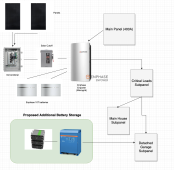Have a fully functional Enphase Encharge battery system with two of the 10T batteries, solar panels of course. Location is NorCal in PG&E territory. My installer advised me I could only have two of the Encharge 10T batteries (20 kWh total). This is not an Enphase technical limitation, I think its a PG&E SGIP limitation as, pre-EV, I could not document sustained loads over 12kW. Enphase batteries are great, but the $/watt isn't competitive and I won't add more. Note large ranch style property with outbuildings in a wildfire shutdown zone.
Goal, harness solar production during the day and zero out (peak-shave) the evening Time of Use rates.
Proposal: AC couple a sufficient spec on-grid smart inverter with an additional battery storage.
Goal, harness solar production during the day and zero out (peak-shave) the evening Time of Use rates.
Proposal: AC couple a sufficient spec on-grid smart inverter with an additional battery storage.
- Inverter and storage must be located on a subpanel in an outbuilding. Space not available near the main panel.
- Inverter needs to "play well" with Enphase Enpower micro-grid, so UL1741SA. Other considerations ? Inverter will be located "downstream", that is as part of the microgrid.
- Inverter can either function on existing Enphase microgrid and with existing Enphase batteries during a power outage / grid disconnect, or it must shut itself down. Obviously prefer it to run.
- Baseline consumption is ~2kW for house, pool, workshop and network equipment. I can grab real-time consumption data from Rainforest Eagle and/or Enphase, or even insert another IOTAwatt to dynamically adjust the grid-feed of the inverter. Since my goal here is electrical safety, let's assume I just program the smart inverter to "sell" 2.5kW / hour from 3 pm until midnight, and charge batteries from 10 am until done.
- Inverter will NOT have solar panels installed. Outbuilding is fully shaded. Inverter doesn't need MPPT charger. Also skip the AC coupling 1:1 rule ?
- No plan to put load directly on inverter. Inverter installation is essentially removeable.
- Inverter needs to be capable of working safely with US 60Hz 240v output into a subpanel with a 125A breaker. Suggest sizing the inverter to 5~8kW on appropriate sized breaker, as the goal is to offset peak consumption rather than run the entire house.
- Inverter and batteries need to be UL listed, prefer closed-loop BMS.
- Evaluating Fortress Battery eFlex 5.4 and Victron Hybrid inverters.
- Experience: I'm a systems engineer during the day, have some residential electrical experience and a licensed electrician on standby to assist the project.




